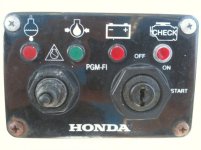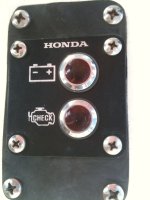We've got a Honda BF225 thats a bit over three years old with about 225 hours on the engine and have two problems. Recently there has been a intermittent alarm that goes off when the boat is at idle (after running about 10 minutes at higher rpms). The beeping alarm goes off until we turn the motor off, then it restarts fine and there is no alarm. Green light on console (oil okay) and no red lights go on until the intermittent/pulsing alarm goes off and then both red check engine lights go on. I don't have the mechanics manual and am unsure on how to get the blinking light codes in the actual motor.
I've read thru the boards here and read the manual and then checked the water separator, there didn't seem to be any water mixed with the fuel (I drained it, then cleaned it and reinstalled it). The big water/fuel separator running from the fuel tank to the motor also did not have any water in it. Because it is only happening after running partial to full throttle and then the alarm comes on when it's in neutral could this be from the oxygen sensor going bad? Is there anything else we should be looking for that's common with a pulsing alarm? I thought for sure it was the water separator but after cleaning it out and running the boat again today we had the same problem.
The second problem which has been getting worse is there is a loud CLUNK sound when we put the motor in reverse, I'm not sure if it is the motor slipping out of gear or not but there will be several clunks in succession if we have it in reverse and ease the throttle, this clunking seems to be getting worse.
Any help would be appreciated, thanks!
I've read thru the boards here and read the manual and then checked the water separator, there didn't seem to be any water mixed with the fuel (I drained it, then cleaned it and reinstalled it). The big water/fuel separator running from the fuel tank to the motor also did not have any water in it. Because it is only happening after running partial to full throttle and then the alarm comes on when it's in neutral could this be from the oxygen sensor going bad? Is there anything else we should be looking for that's common with a pulsing alarm? I thought for sure it was the water separator but after cleaning it out and running the boat again today we had the same problem.
The second problem which has been getting worse is there is a loud CLUNK sound when we put the motor in reverse, I'm not sure if it is the motor slipping out of gear or not but there will be several clunks in succession if we have it in reverse and ease the throttle, this clunking seems to be getting worse.
Any help would be appreciated, thanks!
Last edited:



